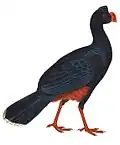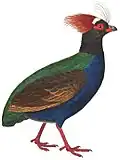| Amitabha urbsinterdictensis Temporal range: Middle Eocene | |
|---|---|
| Scientific classification | |
| Domain: | Eukaryota |
| Kingdom: | Animalia |
| Phylum: | Chordata |
| Class: | Aves |
| Genus: | †Amitabha Gulas-Wroblewski and Wroblewski, 2002 |
| Species: | †A. urbsinterdictensis |
| Binomial name | |
| †Amitabha urbsinterdictensis Gulas-Wroblewski and Wroblewski, 2002 | |
Amitabha urbsinterdictensis is an ancient bird from the Middle Eocene (approximately 50 million years before the present) in North America. One specimen has been found to date. Bonnie Gulas-Wroblewski and Anton Wroblewski described and named it in 2002.[1]
Specimens
The only known specimen of A. urbsinterdictensis is the type, AMNH 30331, which consists of a partial skeleton, including an incomplete humerus, scapula, sternum, and pelvis.[2] It is from the Bridger Formation of Wyoming, which is of Middle Eocene age.[1]
Relationships
In their 2002 paper, Gulas-Wroblewski and Wroblewski found A. urbsinterdictensis to be a crown-group galliform, and a member of the "phasianoids", the group that also includes such birds as peacocks, pheasants, and turkeys.[1] Gerald Mayr criticized this analysis.[2] A 2009 study by Daniel Ksepka found the species to belong neither to the crown nor the stem of the galliformes, but rather to have affinities to the rails.[3]
Name
Explaining their choice of name, Gulas-Wroblewski and Wroblewski wrote, "urbsinterdictensis refers to the "Forbidden City" locality of Wyoming. Amitabha is for Amitabha Buddha, the bodhisattva of enlightenment and compassion, who commonly adopts the form of a peacock when incarnated in the material world".[1]
References
Literature cited
- Gulas-Wroblewski, Bonnie E.; Wroblewski, Anton F.-J. (November 2003). "A crown-group galliform bird from the Middle Eocene Bridger Formation of Wyoming". Palaeontology. 46 (6): 1269–1280. doi:10.1046/j.0031-0239.2003.00340.x.
- Mayr, Gerald (2009). Paleogene Fossil Birds. Berlin, Germany: Springer. ISBN 978-3-540-89627-2.
- Ksepka, D. T. (2009). "Broken gears in the avian molecular clock: new phylogenetic analyses support stem galliform status for Gallinuloides wyomingensis and rallid affinities for Amitabha urbsinterdictensis". Cladistics. 25: 173–197. doi:10.1111/j.1096-0031.2009.00250.x.


